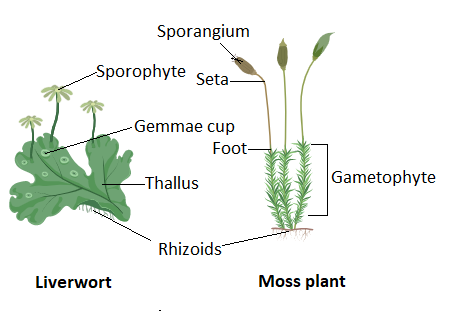
Enumerate the salient features of bryophytes.
Answer
548.7k+ views
Hint:Bryophytes are the amphibians of the plant kingdom as they can be both aquatic and terrestrial. But they are solely dependent on water for sexual reproduction. They are key communities in primary succession. They do not have differentiated plant parts but have root-like and stem-like structures.
Complete answer:
Bryophytes are a non-vascular plant group consisting of three major divisions called hornworts, mosses, and liverworts. They lack vascular tissues like xylem and phloem. They are limited-sized moist habitats preferring plant-like structures. About 20, 000 plant species have been classified as bryophytes.

They produce enclosed gametangia and sporangia which are the reproductive structures. They do not produce seeds or flowers. They reproduce by means of spores. Spore formation occurs through sexual reproduction. They can grow both on terrestrial and aquatic substrates but depend on water for sexual reproduction. Therefore, they are regarded as the amphibians of the plant kingdom. They can reproduce vegetatively through adventitious buds.
The plant body of bryophytes is gametophyte and is not differentiated into plant parts like root, stem, and leaf. They have thallus like structures, some mosses show leaf-like and stem-like structures. They have modified root types called rhizoids. The three recognizable structures of bryophytes are the foot, seta, and the capsule. The foot helps absorbing water and nutrients as it is a basal part. The capsule encloses spore mother cells that are diploid. These diploid spores undergo meiosis to form haploid spores. Most of the bryophytes are primitive land dwellers with some of them aquatic like Ricciocarpus, Riella, etc.
The sporophytic phase of bryophytes is represented by sporangium, zygote, and embryo. The gametophytic phase is characterized by the long-living green haploid phase. There is an alternation of generation as the haploid gametophytic phase alternates with diploid.
Note: Bryophytes are used in soil conditioning, making of moss gardens, etc. They are cheap and reliable bioindicators as they are excellent indicators of soil pollution. Most of them are used as pesticides in crop fields. Plgiochila is a liverwort that is known to secrete harmful chemical substances against mice.
Complete answer:
Bryophytes are a non-vascular plant group consisting of three major divisions called hornworts, mosses, and liverworts. They lack vascular tissues like xylem and phloem. They are limited-sized moist habitats preferring plant-like structures. About 20, 000 plant species have been classified as bryophytes.

They produce enclosed gametangia and sporangia which are the reproductive structures. They do not produce seeds or flowers. They reproduce by means of spores. Spore formation occurs through sexual reproduction. They can grow both on terrestrial and aquatic substrates but depend on water for sexual reproduction. Therefore, they are regarded as the amphibians of the plant kingdom. They can reproduce vegetatively through adventitious buds.
The plant body of bryophytes is gametophyte and is not differentiated into plant parts like root, stem, and leaf. They have thallus like structures, some mosses show leaf-like and stem-like structures. They have modified root types called rhizoids. The three recognizable structures of bryophytes are the foot, seta, and the capsule. The foot helps absorbing water and nutrients as it is a basal part. The capsule encloses spore mother cells that are diploid. These diploid spores undergo meiosis to form haploid spores. Most of the bryophytes are primitive land dwellers with some of them aquatic like Ricciocarpus, Riella, etc.
The sporophytic phase of bryophytes is represented by sporangium, zygote, and embryo. The gametophytic phase is characterized by the long-living green haploid phase. There is an alternation of generation as the haploid gametophytic phase alternates with diploid.
Note: Bryophytes are used in soil conditioning, making of moss gardens, etc. They are cheap and reliable bioindicators as they are excellent indicators of soil pollution. Most of them are used as pesticides in crop fields. Plgiochila is a liverwort that is known to secrete harmful chemical substances against mice.
Recently Updated Pages
Why are manures considered better than fertilizers class 11 biology CBSE

Find the coordinates of the midpoint of the line segment class 11 maths CBSE

Distinguish between static friction limiting friction class 11 physics CBSE

The Chairman of the constituent Assembly was A Jawaharlal class 11 social science CBSE

The first National Commission on Labour NCL submitted class 11 social science CBSE

Number of all subshell of n + l 7 is A 4 B 5 C 6 D class 11 chemistry CBSE

Trending doubts
10 examples of friction in our daily life

One Metric ton is equal to kg A 10000 B 1000 C 100 class 11 physics CBSE

Difference Between Prokaryotic Cells and Eukaryotic Cells

1 Quintal is equal to a 110 kg b 10 kg c 100kg d 1000 class 11 physics CBSE

State the laws of reflection of light

Explain zero factorial class 11 maths CBSE




